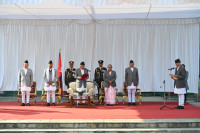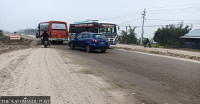National
A new school book on Nepal’s border disputes with India shows government’s misplaced priority, experts say
Academicians take issues with the preface of the book as well where the education minister has attempted to justify why the book was needed and how he himself was once part of a campaign to ‘protect the territory’.
Binod Ghimire
At a time when Nepal and India were seeing some positive gestures in the resumption of dialogue after months-long deadlock due to a “cartographic war”, the government on Tuesday released “a reference book” for school students, which dwells on border disputes, mainly with the southern neighbour, in a move that could further shrink the space for bilateral talks.
The publication of the book, according to Minister for Education Giriraj Mani Pokharel, was triggered by the Indian government’s move on November 2 last year to publish its political map depicting Kalapani within Indian borders. Nepal claims Kalapani as its own territory.
The two countries, however, reached a state of cartographic war in May when Indian defence minister inaugurated a road link via Lipulekh to Kailash Mansarovar in the Tibet Autonomous Region of China. Nepal responded with its own new political map depicting Kalapani, Lipulekh and Limpiyadhura within its borders.
India rejected the new map, calling Nepal’s move cartographic assertion.
Now a book to “teach students” about Nepal’s territory and border disputes, mainly with India, has raised questions whether it was necessary and whether it was needed at this time when the government has several other pressing issues to address.
“Is this the right time to come out with such a book,” said Khadga KC, head of the Department of International Relations and Diplomacy at Tribhuvan University. “Such moves should be taken after a proper study of their consequences.”
After getting defeated in the 1962 war with China, then Indian prime minister Jawaharlal Nehru requested king Mahendra to allow India to keep its army for some time. But even after 60 years, instead of taking its army from the land that was given to it temporarily, the Indian government rather issued a map putting the area within its territory, reads a part in the book.
Page 27 of the book says that of the 27 districts bordering with India, there are disputes in 24 places. “Some incidents of land encroachment can be attributed to locals’ acts while others are due to deliberate and planned moves by India,” reads one of the paragraphs.
“A country’s curricula should be designed to produce academics, not activists,” said Mrigendra Bahadur Karki, an associate professor at the Centre for Nepal and Asian Studies. “Such books neither help produce an informed new generation nor facilitate dialogue between the countries at a time of frayed ties.”
Many say the preface of the book, prepared for 9th to 12the graders, is more problematic than the content.
The preface, written by Minister Pokhrel himself, tries to explain how he campaigned 24 years back “to chase” the Indian Army away from the Nepali territory.
Pokhrel represents the former Maoist party which once during the decade-long insurgency had declared a war against Nepal’s southern neighbour, for which the Maoists claimed that they were even digging a tunnel.
The Maoist leaders’ relationships with India, however, were chronicled by various scholars after the civil conflict ended in 2006, to depict the double standards then rebels demonstrated vis-a-vis India.
“The language used by Pokhrel [in the preface] is highly undiplomatic,” Karki told the Post.
The diplomatic experts and academicians, however, say the book is an example to show the shortsightedness of the government, which could pollute the environment for the dialogue with India.
The experts also have raised a question over the language used in the preface written by Pokharel himself. In the six-page preface, he has explained how he campaigned 24-years back with a motive to chase the Indian Army away from the Nepali territory. “It was natural for a proud Nepali to get hurt by the move of India to publish its political map incorporating Nepal’s land from Kalapani, Lipulekh and Limpiyadhura area,” reads one of the lines in the preface.
Academicians say there is no practice of a minister writing the preface for an academic book and that Pokhrel seems to have used the book as a tool to project his nationalist posture.
“This looks like a populist move of the education minister,” Binaya Kusiyait, a professor at Tribhuvan University who has researched on school education. “He may be hoping that publication of such a book would compensate for his failure.”
According to Kusiyait, the book is just another example of the minister’s misplaced priority.
“The minister instead should have been working on finding ways to ensure education for thousands of children who have been deprived of education due to the pandemic,” said Kusiyait. “He has squandered state resources and wasted time by publishing the book which is not needed at all.”
In general, history or social studies textbooks have lessons on a country’s past and relations with neighbours and other nations.
Such lessons on the country’s history, culture and cultural relations with other nations help in producing informed citizens, according to academicians. But the newly published book seems to inculcate negativity about and contempt for a neighbouring country, they say.
“Nepal should refrain from any move that irritates India because that will disrupt an environment for dialogue,” Lok Raj Baral, a former professor at Tribhuvan University and Nepal’s former ambassador to India, told the Post. “A chapter in any other textbook about the new map and the incidents that led up to the constitution amendment could have been enough, instead of publishing a whole new book.”
Officials at the Curriculum Development Centre, which published the book, say Minister Pokharel was involved in the entire drafting process.
Along with the border disputes, the book titled, “A reference material on Nepal’s Territory Border”, has historical facts about Nepal’s territory, how borders are decided and what leads to border disputes and ways to resolve them.
The decision to prepare the book was taken on July 3 and the entire drafting process and publication was completed in less than three months.
“We could have published the book a few weeks before. It took time to get the consent from the prime minister and other concerned ministries,” Kesab Dahal, director general at the centre, told the Post.
Deep Kumar Upadhyay, Nepal’s former ambassador to India, said it’s even more troubling that the prime minister himself took interest and gave the consent for such a book.
“If Pokharel wrote such an outrageous preface with Oli’s consent, then it is even more problematic,” Upadhyay told the Post.
Oli, who returned to power riding on his nationalistic posturing, especially his anti-India stance, has of late made some statements attacking the southern nieghbour. Besides saying “Indian virus” is more lethal than the Chinese or Italian virus, Oli once took issues with India’s national emblem also. Then again, speaking at a programme to commemorate the birth anniversary of Bhanubhakta Acharya on July 13, Oli accused India of cultural aggression, saying it had created a fake Ayodhya and that the real Ayodhya lies in Nepal.
According to Oli, Lord Ram was born in Nepal. He has even instructed local authorities of Madi Municipality in Chitwan to build a Ram temple there.
Analysts say all the neighbouring nations have their own issues but the governments try to iron out the differences through dialogue.
“Instead of trying to create an environment for dialogue, the government is engaged in publishing a book which barely serves any purpose,” said Upadhyay. “Both countries should try to find an amicable solution to the problem in hand, and the book by the Nepal government is definitely not the way to go about.”




 7.12°C Kathmandu
7.12°C Kathmandu















